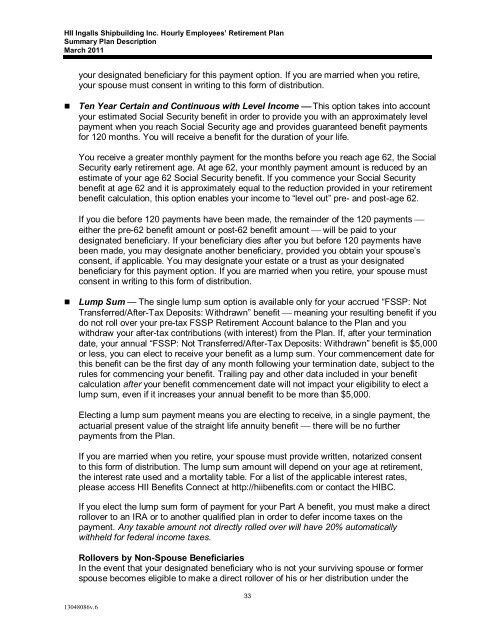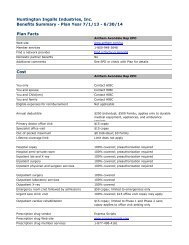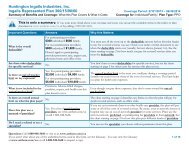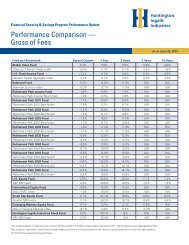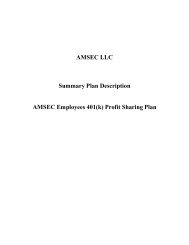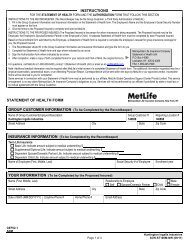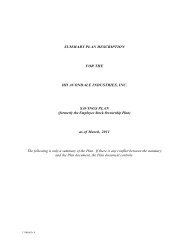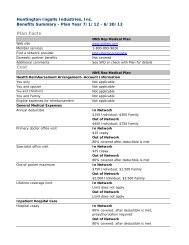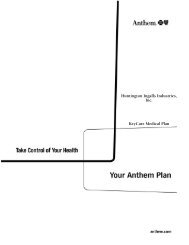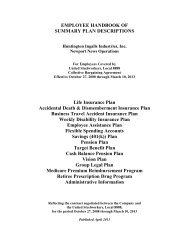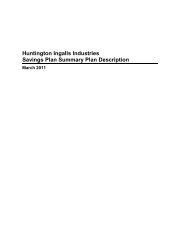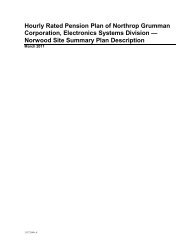HII Ingalls Shipbuilding Inc. Hourly Employees ... - Benefits Connect
HII Ingalls Shipbuilding Inc. Hourly Employees ... - Benefits Connect
HII Ingalls Shipbuilding Inc. Hourly Employees ... - Benefits Connect
You also want an ePaper? Increase the reach of your titles
YUMPU automatically turns print PDFs into web optimized ePapers that Google loves.
<strong>HII</strong> <strong>Ingalls</strong> <strong>Shipbuilding</strong> <strong>Inc</strong>. <strong>Hourly</strong> <strong>Employees</strong>’ Retirement Plan<br />
Summary Plan Description<br />
March 2011<br />
your designated beneficiary for this payment option. If you are married when you retire,<br />
your spouse must consent in writing to this form of distribution.<br />
• Ten Year Certain and Continuous with Level <strong>Inc</strong>ome ⎯ This option takes into account<br />
your estimated Social Security benefit in order to provide you with an approximately level<br />
payment when you reach Social Security age and provides guaranteed benefit payments<br />
for 120 months. You will receive a benefit for the duration of your life.<br />
You receive a greater monthly payment for the months before you reach age 62, the Social<br />
Security early retirement age. At age 62, your monthly payment amount is reduced by an<br />
estimate of your age 62 Social Security benefit. If you commence your Social Security<br />
benefit at age 62 and it is approximately equal to the reduction provided in your retirement<br />
benefit calculation, this option enables your income to “level out” pre- and post-age 62.<br />
If you die before 120 payments have been made, the remainder of the 120 payments ⎯<br />
either the pre-62 benefit amount or post-62 benefit amount ⎯ will be paid to your<br />
designated beneficiary. If your beneficiary dies after you but before 120 payments have<br />
been made, you may designate another beneficiary, provided you obtain your spouse’s<br />
consent, if applicable. You may designate your estate or a trust as your designated<br />
beneficiary for this payment option. If you are married when you retire, your spouse must<br />
consent in writing to this form of distribution.<br />
• Lump Sum — The single lump sum option is available only for your accrued “FSSP: Not<br />
Transferred/After-Tax Deposits: Withdrawn” benefit ⎯ meaning your resulting benefit if you<br />
do not roll over your pre-tax FSSP Retirement Account balance to the Plan and you<br />
withdraw your after-tax contributions (with interest) from the Plan. If, after your termination<br />
date, your annual “FSSP: Not Transferred/After-Tax Deposits: Withdrawn” benefit is $5,000<br />
or less, you can elect to receive your benefit as a lump sum. Your commencement date for<br />
this benefit can be the first day of any month following your termination date, subject to the<br />
rules for commencing your benefit. Trailing pay and other data included in your benefit<br />
calculation after your benefit commencement date will not impact your eligibility to elect a<br />
lump sum, even if it increases your annual benefit to be more than $5,000.<br />
Electing a lump sum payment means you are electing to receive, in a single payment, the<br />
actuarial present value of the straight life annuity benefit ⎯ there will be no further<br />
payments from the Plan.<br />
If you are married when you retire, your spouse must provide written, notarized consent<br />
to this form of distribution. The lump sum amount will depend on your age at retirement,<br />
the interest rate used and a mortality table. For a list of the applicable interest rates,<br />
please access <strong>HII</strong> <strong>Benefits</strong> <strong>Connect</strong> at http://hiibenefits.com or contact the HIBC.<br />
If you elect the lump sum form of payment for your Part A benefit, you must make a direct<br />
rollover to an IRA or to another qualified plan in order to defer income taxes on the<br />
payment. Any taxable amount not directly rolled over will have 20% automatically<br />
withheld for federal income taxes.<br />
Rollovers by Non-Spouse Beneficiaries<br />
In the event that your designated beneficiary who is not your surviving spouse or former<br />
spouse becomes eligible to make a direct rollover of his or her distribution under the<br />
13048086v.6<br />
33


